The Montana lease agreement renders a legal guarantee for a lessor to permit the right of use of a property for a predetermined duration and financial payment schedule. The contract narrows down the details of the transaction and regulates the process and procedure. The document secures the legitimacy of the lease and protects both the tenant and landlord from any liability.
Lease Agreements By Type
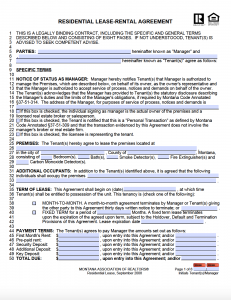 Montana Association of Realtors Residential Lease-Rental Agreement – A uniform document published by the state Realtors organization to provide members with a transaction record.
Montana Association of Realtors Residential Lease-Rental Agreement – A uniform document published by the state Realtors organization to provide members with a transaction record.
Download: PDF
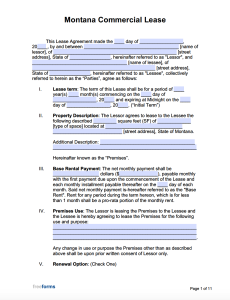 Commercial Lease Agreement – Produces a written bond defining the terms to lease a piece of real estate for a designated time.
Commercial Lease Agreement – Produces a written bond defining the terms to lease a piece of real estate for a designated time.
Download: PDF, Word (.docx)
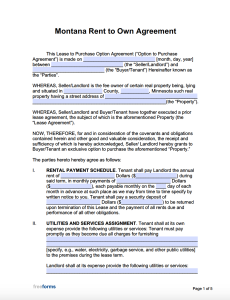 Lease to Own Agreement – Formulates a contract to lease a domicile for a laid-out monthly payment arrangement. An alternate clause is included to allow the first right of refusal to purchase once the lease comes to an end.
Lease to Own Agreement – Formulates a contract to lease a domicile for a laid-out monthly payment arrangement. An alternate clause is included to allow the first right of refusal to purchase once the lease comes to an end.
Download: PDF, Word (.docx)
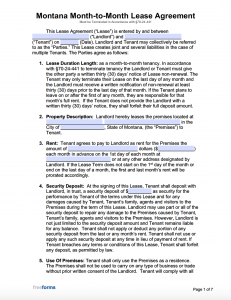 Month-to-Month Lease – Puts forth a documenting instrument that details the provisions to rent a property. This particular agreement permits either party to end the commitment before the duration is completed with thirty (30) day notification.
Month-to-Month Lease – Puts forth a documenting instrument that details the provisions to rent a property. This particular agreement permits either party to end the commitment before the duration is completed with thirty (30) day notification.
Download: PDF, Word (.docx)
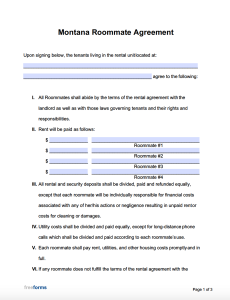 Roommate Agreement – Builds a corroborated covenant to rent a portion of a dwelling for a predetermined period and dollar amount.
Roommate Agreement – Builds a corroborated covenant to rent a portion of a dwelling for a predetermined period and dollar amount.
Download: PDF, Word (.docx)
Standard Lease Agreement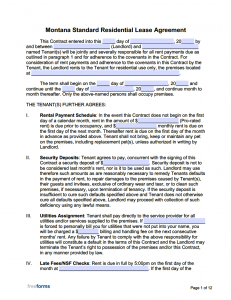 – Purveys an approved document to cover the associated provisions and regulations incorporated into a leasing arrangement.
– Purveys an approved document to cover the associated provisions and regulations incorporated into a leasing arrangement.
Download: PDF, Word (.docx)
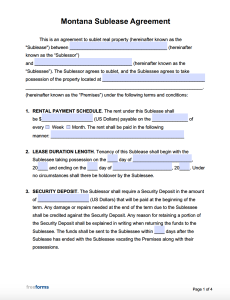 Sublease Agreement – Devises a contract for a lessee to reassign tenancy to a separate individual for an agreed-upon payment.
Sublease Agreement – Devises a contract for a lessee to reassign tenancy to a separate individual for an agreed-upon payment.
Download: PDF, Word (.docx)
Landlord-Tenant Laws
The Montana Code Annotated – Residential Landlord and Tenant Act of 1977 elaborates the comprehensive explanation of the laws associated with residential rental properties. Further interpretation of the law regarding Residential Tenants’ Security Deposits is defined in the provided link.
Required Landlord Disclosures
Identification of the Landlord or Authorized Personel (§ 70-24-301) – Within the presented lease agreement, the current names and addresses must be declared as to the owner and management of the rented residence.
Move-In Checklist (§ 70-25-206) – All residential homes that are leased with the requirement of a security deposit, are mandated to present a written register of any defects to the residence at the lease-start. The objective record must be signed by the owner or management company to be compared to the condition of the property upon termination of the lease.
Lead-Based Paint (42 U.S. Code § 4852d) – The federal government has assessed the risks posed by exposure to lead-based paint and subsequently has required disclosure to renters and buyers of homes built before 1979. Supplemental materials to educate a tenant must be circulated along with a disclosure statement to be signed with the leasing documents.
Mold Disclosure (§ 70-16-703) – The lessor is obligated to disclose any knowledge of mold found present in the rental unit. The form communicates the absence of mold on the premises according to the best knowledge of the lessor. The presented disclosure is required to be signed by the lessee upon entering into a lease agreement.
When is Rent Late?
The state of Montana stipulates that if the due date is not pinpointed in the lease literature, then it is expected at the beginning of the month. There is no stated grace period within the regulatory law allowing for evasion of fees posed by the lease agreement (§ 70-24-201).
Late Fees
There is no statute covering a maximum amount a landlord can potentially charge should a rental payment be issued passed the represented due date. For an owner to demand a particular late fee, it must be viewable within the signed lease agreement for compensation of the fee to be obligatory.
NSF Checks
Checks returned for reasons of insufficient funds can trigger a fee to the tenant if explicitly stated in the leasing paperwork. The charge for each check can be no more than a total of $30 in addition to any prescribed fees from the check-cashing institution (§ 27-1-717).
Security Deposit Maximum
Montana Code does not put forth an observed view on a maximum amount that can be charged for a security deposit on a rental property. The sum total is to be secured in an account separate from any commingled funds for the duration of the lease term.
Security Deposit Return
Upon the termination of the lease, the landlord must refund the security deposit to the tenant within ten (10) days of vacating the property. This is the case when the residence is returned with no damage, and all rental payments have been paid in full. In situations where deductions must be made for repair, cleaning, or unpaid rent, the accounting of the costs along with the remaining balance must be sent to the forwarding address of the tenant. The itemized list and reimbursement is to be issued within thirty (30) days of either the tenant vacating or lease-end (whichever is first) (§ 70-25-202).
Landlord’s Entry
The owner of a building is responsible for informing a tenant at least twenty-four (24) hours in advance before entering the premises for required maintenance. Once notification is given, the landlord will only be allowed to gain access during regular hours of the day (§ 70-24-312).



0 comments
Comments are closed.